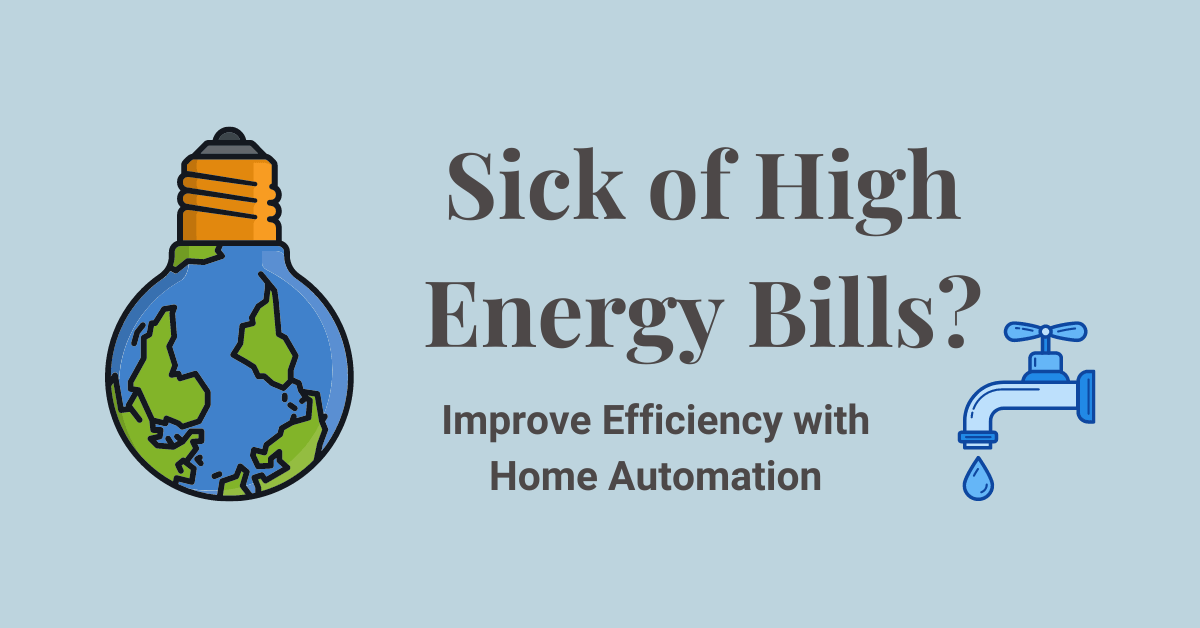If you’re tired of sky-high energy bills and want to do your part to save the planet, it’s time to start automating your home for energy efficiency. Gone are the days of manual thermostat adjustments and leaving appliances on standby. With the latest home automation tech, you can easily take control of your energy consumption and watch those savings add up. From smart plugs to smart sprinkler systems, the options seem endless and are growing.
First, you will need to choose a major smart home platform and assistant to control the various devices in your home. All of these can help you save energy by making it easier to schedule and/or turn off or reduce the power consumption of devices when they are not needed. They are:
- Amazon Echo with Alexa
- Apple HomeKit with Siri
- Google Nest with Google Assistant
As I’ve stated before, I invested in Amazon’s technology primarily because there seems to be much more choice in the growing list of compatible devices.
Table of Contents
Home Automation Ideas
Consider installing and using the following:
Smart thermostats
Smart thermostats can be scheduled and programmed (or even adapt through learning) to turn off the heating or air conditioning when the home is empty, or when the desired temperature has been reached. Some can even remind you to change your system’s air filter.
Smart plugs or outlets
Smart plugs or outlets can be used to control appliances and other devices that use electricity, especially “energy vampires” like televisions, computers, refrigerators, electric toothbrushes, and kitchen appliances. They can be scheduled to be on and off at desired times. I use my smart plugs to schedule my “old-fashioned” (by today’s standards anyway) slow cookers that don’t have a built-in timer. Another plug manages my mood lighting but only at certain times. I have yet to replace my standard outlets but if I were building a new home again, I would opt to have those installed.
Smart lighting and lightbulbs
Smart lighting systems can be programmed to turn off lights when they are not needed, such as when a room is unoccupied or when natural light is sufficient. Some of my lights come on at sunset and go off at designated times at night. I also dim some of the lights for a more relaxing atmosphere. LEDs and dimming lights can contribute to energy savings.
Smart switches
Smart switches can be scheduled to control ceiling fans, lighting, and appliances. Some smart switches include motion detection and will turn on lights, for example, when someone enters a room. With Alexa specifically, I’ve already set it up so that certain lights will turn on with any movement in particular rooms during specific times of the day or night.
Smart power strips
A smart power strip allows you to control multiple devices at once, so you can turn off all of your electronics with a single button. This can be especially useful for devices that continue to use power even when they are turned off, such as chargers and video game consoles and other “energy vampires.”
Smart sprinkler system
A smart sprinkler system can be programmed to turn off the water when it is not needed, such as when it is raining or when the soil is already moist. This can help save water and energy by preventing the sprinkler system from running unnecessarily.
Smart garage door opener
A smart garage door opener can be programmed to close the garage door automatically when you leave the house, helping to prevent drafts. Smart garage door openers are typically equipped with DC motors which are more energy efficient than traditional AC motors.
Smart door locks
A smart door lock gets its power from batteries, which can be recharged or replaced as needed, and not your home’s electricity, and can be programmed to lock the doors automatically when you leave the house, helping to prevent drafts. They also often have low-power modes or sleep modes that activate when the lock is not in use, further reducing power consumption.
Smart home security system
A smart home security system can be programmed to turn off the lights and appliances when you leave the house. These systems typically include a combination of sensors, cameras, and other devices that work together to detect and deter potential security threats. Some common features of smart home security systems include integration with other smart devices, such as thermostats, lighting, and appliances.
Smart window coverings
Smart window coverings can be programmed to open and close automatically based on the time of day and/or the amount of sunlight or temperature in the room. This can help regulate the temperature in your home. Some examples of smart window coverings include motorized shades, curtains, and blinds.
Smart washing machine
A smart washing machine can be programmed to run only when energy demand is low. Like other more advanced washers, smart washers may have energy-saving modes and use sensors to detect the weight of clothes and adjust the wash time, water, and detergent usage accordingly for optimal results. Connected apps help you monitor the progress of your laundry, receive alerts when the cycle is complete, and troubleshoot potential issues.
Smart dryer
Some smart dryers allow you to start, stop, and adjust the settings of your dryer remotely. Like other more advanced dryers, smart dryers include energy-saving modes and sensors to detect moisture levels in clothes and adjust the drying time and temperature accordingly for optimal results. Connected apps help you monitor the progress of your laundry, receive alerts when the cycle is complete, and troubleshoot potential issues.
Smart pool pump
A smart pump typically has built-in intelligence and can be programmed to run at specific times, adjust its speed based on pool usage, and even self-diagnose and troubleshoot issues. Smart pool pumps can also integrate with other smart home devices, such as lighting systems, to create a more efficient and convenient pool experience.
Smart ceiling fans
A smart ceiling fan can be programmed to turn off when it is not needed, can make a room feel cooler in the summer and circulate heated air in the winter.
Smart hot water heater controller
A smart hot water heater controller is a device that allows you to control and monitor the temperature and operation of your hot water heater remotely. The main advantage of a smart hot water heater controller is the ability to save energy by adjusting the temperature of the water heater based on usage patterns and preferences, and also to turn it off when it’s not needed.
Smart air conditioners
Features of a smart air conditioner include remote control, energy monitoring, automatic scheduling, voice control, and smart integration with other smart home automation systems. Smart air conditioners offer convenience and energy savings by providing the ability to control and monitor the air conditioner remotely, and also to adapt to your schedule, usage patterns, and preferences.
Smart leak detectors
Smart leak detectors are devices that use sensors to detect the presence of water leaks and alert homeowners to potential problems. They can be placed near potential leak sources such as water heaters, washing machines, and sinks, and can connect to a home’s Wi-Fi network to send notifications to a smartphone or other device when a leak is detected. Some smart leak detectors also include shut-off valves that can automatically turn off the water supply to prevent further damage if a leak is detected.
With the rising cost of energy, it’s more important than ever to take steps to improve efficiency in your home. By utilizing home automation, you can do just that and enjoy the added convenience and peace of mind it brings.
TIP: Can’t decide between your bulb’s existing technology and a LED or smart version of a bulb, for example, try this calculator (and others available on the web).


